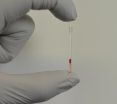(Press-News.org) The quality of the U.S. diet showed some modest improvement in the last decade in large measure because of a reduction in the consumption of unhealthy trans fats, but the gap in overall diet quality widened between the rich and the poor.
An unhealthy diet is closely linked to cardiovascular disease, diabetes and some cancers. Eating a healthy diet is an important part of the strategy to prevent adverse health outcomes. Evaluating population trends in diet quality is important because it can offer guidance for public health policy.
The authors used the Alternate Healthy Eating Index 2010 (AHEI-2010) to investigate trends in diet quality in the U.S. adult population from 1999 to 2010 using a sample of 29,124 adults from the National Health and Nutrition Examination Survey (NHANES). A higher AHEI-2010 score indicated a more healthful diet. The index's components were scored from 0 to 10. For fruits, vegetables, whole grains, nuts and legumes, long-chain omega-3 fats and polyunsaturated fatty acids (PUFAs), a higher score corresponded to higher intake. For trans fat, sugar-sweetened beverages and fruit juices, red and/or processed meat and sodium, a higher score corresponded to lower intake. The authors used a recently updated index, the Healthy Eating Index 2010 (HEI-2010) for further analysis.
The energy-adjusted average AHEI-2010 score increased from 39.9 in 1999- 2000 to 46.8 in 2009- 2010. Reduced trans fat intake accounted for more than half of this improvement. Scores increased by 0.9 points for sugar-sweetened beverages and fruit juice reflecting decreased consumption. Score increases of 0.7 points for whole fruit, 0.5 points for whole grains, 0.5 points for PUFAs and 0.4 points for nuts and legumes reflected increased consumption. A decrease in scores for sodium reflected greater consumption. Having a lower body mass index (BMI) also was associated with dietary improvement. Diet quality scores in the high-socioeconomic status (SES) group, associated with both income and education, were consistently higher than in the lower-SES groups and that gap widened over time from 3.9 points in 1999-2000 to 7.8 points in 2009-2010.
"Our study suggests that the overall dietary quality of the U.S. population steadily improved from 1999 through 2010. This improvement reflected favorable changes in both consumers' food choices and food processing, especially the reduction of trans fat intake, that were likely motivated by both public policy and nutrition education. However, overall dietary quality remains poor, indicating room for improvement and presenting challenges for both public health researchers and policy makers. Furthermore, substantial differences in dietary quality were seen across levels of SES, and the gap between those with the highest and lowest levels increased over time."
Author: Dong D. Wang, M.D., M.Sc., of the Harvard School of Public Health, Boston, and colleagues.
(JAMA Intern Med. Published online September 1, 2014. doi:10.1001/jamainternmed.2014.3422. Available pre-embargo to the media at http://media.jamanetwork.com.)
Editor's Note: Please see the article for additional information, including other authors, author contributions and affiliations, financial disclosures, funding and support, etc.
Commentary: Growing Socioeconomic Disparity in Dietary Quality
In a related commentary, Takehiro Sugiyama, M.D., Ph.D., of the National Center for Global Health and Medicine, Tokyo, and Martin F. Shapiro, M.D., Ph.D., of the University of California, Los Angeles, write: "The growing chasm in dietary quality by SES confronts us with the possibility that the governmental efforts to mind this gap have been insufficient. It is disappointing that the improvement seen in those of higher SES was not seen in the lower-SES group."
"How could we close the dietary quality gap? First, we could restrict benefits to more healthful foods, as has been done by the Special Supplemental Nutrition Program for Women, Infants and Children (WIC), which restricts purchasable foods with the benefit," they continue.
"Other strategies to improve dietary quality include providing healthful foods to students and residents in underserved areas," they note.
(JAMA Intern Med. Published online September 1, 2014. doi:10.1001/jamainternmed.2014.3048. Available pre-embargo to the media at http://media.jamanetwork.com.)
Editor's Note: Please see the article for additional information, including other authors, author contributions and affiliations, financial disclosures, funding and support, etc.
INFORMATION:
Media Advisory: To contact corresponding author Walter C. Willett, M.D., Dr.P.H., call Marjorie Dwyer 617-432-8416 or email mhdwyer@hsph.harvard.edu. To contact commentary author Takehiro Sugiyama, M.D., Ph.D., email tsugiyama-tky@umin.ac.jp.
Quality of US diet improves, gap widens for quality between rich and poor
2014-09-01
ELSE PRESS RELEASES FROM THIS DATE:
Family dinners good for teens' mental health, could protect from cyberbullying
2014-09-01
Bottom Line: Cyberbullying was associated with mental health and substance use problems in adolescents but family dinners may help protect teens from the consequences of cyberbullying and also be beneficial for their mental health.
Author: Frank J. Elgar, Ph.D., of McGill University, Montreal, Canada, and colleagues.
Background: About 1 in 5 adolescents has experienced recent online bullying and cyberbullying, like traditional bullying, can increase the risk of mental health problems in teens as well as the misuse of drugs and alcohol. It is important to understand ...
Engineers develop new sensor to detect tiny individual nanoparticles
2014-09-01
Nanoparticles, engineered materials about a billionth of a meter in size, are around us every day. Although they are tiny, they can benefit human health, as in some innovative early cancer treatments, but they can also interfere with it through viruses, air pollution, traffic emissions, cosmetics, sunscreen and electronics.
A team of researchers at Washington University in St. Louis, led by Lan Yang, PhD, the Das Family Career Development Associate Professor in Electrical & Systems Engineering, and their collaborators at Tsinghua University in China have developed a new ...
Sierra Nevada freshwater runoff could drop 26 percent by 2100, UC study finds
2014-09-01
Irvine, Calif. — Freshwater runoff from the Sierra Nevada may decrease by as much as one-quarter by 2100 due to climate warming on the high slopes, according to scientists at UC Irvine and UC Merced.
Accelerated plant growth at higher elevations caused by increasing temperatures would trigger more water absorption and evaporation, accounting for the projected runoff declines, the researchers add.
A diminished river flow will only add to the burden of providing resources to the thirsty farms and homes that rely on it. The state is currently experiencing a severe drought, ...
Nature's tiny engineers
2014-09-01
CAMBRIDGE, Mass-- Conventional wisdom has long held that corals — whose calcium-carbonate skeletons form the foundation of coral reefs — are passive organisms that rely entirely on ocean currents to deliver dissolved substances, such as nutrients and oxygen. But now scientists at MIT and the Weizmann Institute of Science (WIS) in Israel have found that they are far from passive, engineering their environment to sweep water into turbulent patterns that greatly enhance their ability to exchange nutrients and dissolved gases with their environment.
"These microenvironmental ...
Location of body fat can increase hypertension risk
2014-09-01
WASHINGTON (Sept. 1, 2014) — People with fat around their abdominal area are at greater risk of developing hypertension when compared to those with similar body mass index but fat concentrations elsewhere on the body, according to a study published today in the Journal of the American College of Cardiology.
Obesity is a known risk factor for hypertension, or high blood pressure, and it is widely reported that the location of fat on a person's body can lead to increased risk of other health issues like heart disease and cancer. However, the relationship between hypertension ...
Ride-sharing could cut cabs' road time by 30 percent
2014-09-01
CAMBRIDGE, Mass-- Cellphone apps that find users car rides in real time are exploding in popularity: The car-service company Uber was recently valued at $18 billion, and even as it faces legal wrangles, a number of companies that provide similar services with licensed taxi cabs have sprung up.
What if the taxi-service app on your cellphone had a button on it that let you indicate that you were willing to share a ride with another passenger? How drastically could cab-sharing reduce traffic, fares, and carbon dioxide emissions?
Authoritatively answering that question ...
Faster, cheaper tests for sickle cell
2014-09-01
Within minutes after birth, every child in the U.S. undergoes a battery of tests designed to diagnose a host of conditions, including sickle cell disease. Thousands of children born in the developing world, however, aren't so lucky, meaning many suffer and die from the disease each year.
A.J. Kumar hopes to put a halt to at least some of those deaths.
A Post-Doctoral Fellow in Chemistry and Chemical Biology working in the lab of George Whitesides, the Woodford L. and Ann A. Flowers University Professor, Kumar and colleagues, including other co-authors, have developed ...
Training your brain to prefer healthy foods
2014-09-01
BOSTON (September 1, 2014, 10:20 AM EDT) — It may be possible to train the brain to prefer healthy low-calorie foods over unhealthy higher-calorie foods, according to new research by scientists at the Jean Mayer USDA Human Nutrition Research Center on Aging (USDA HNRCA) at Tufts University and at Massachusetts General Hospital. Published online today in the journal Nutrition & Diabetes, a brain scan study in adult men and women suggests that it is possible to reverse the addictive power of unhealthy food while also increasing preference for healthy foods.
"We don't start ...
Fruit consumption cuts CVD risk by up to 40 percent
2014-09-01
Barcelona, Spain – Monday 1 September 2014: Daily fruit consumption cuts the risk of cardiovascular disease (CVD) by up to 40%, according to research presented at ESC Congress today by Dr Huaidong Du from Oxford, UK. The findings from the seven year follow-up study of nearly 0.5 million people in the China Kadoorie Biobank found that the more fruit people ate, the more their risk of CVD declined.
Dr Du said: "CVD, including ischaemic heart disease (IHD) and stroke, is the leading cause of death worldwide. Improving diet and lifestyle is critical for CVD risk reduction ...
Permanent AF doubles risk of stroke compared to paroxysmal AF
2014-09-01
Barcelona, Spain – Monday 1 September 2014: Permanent atrial fibrillation (AF) doubles the risk of stroke compared to paroxysmal AF, according to research in more than 6 000 patients presented at ESC Congress today by Dr Thomas Vanassche from Belgium. The findings suggest that a simple clinical assessment of the type of AF can help doctors to better estimate stroke risk.
Ischaemic stroke is the second cause of death in the EU, accounting for over a million deaths and many more disabled patients each year. Annual direct health care costs amount to more than €20 billion. ...



